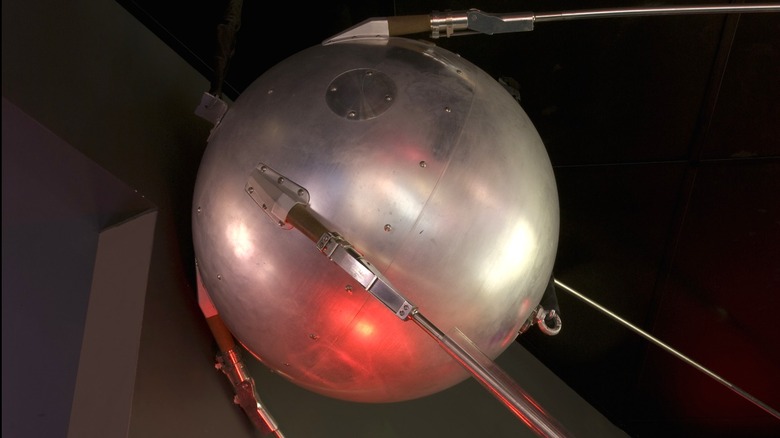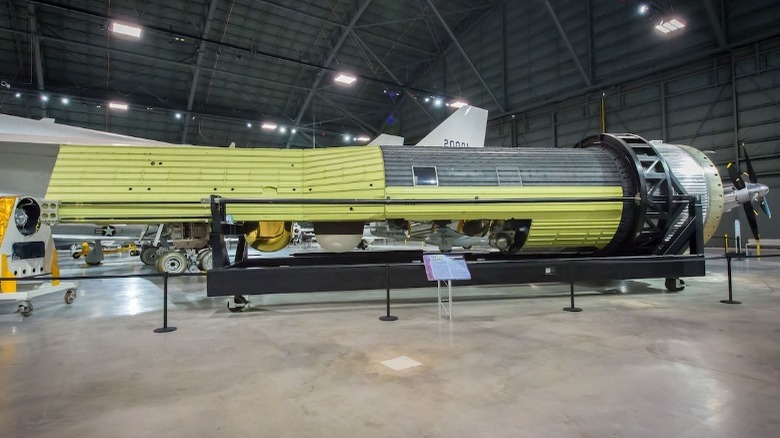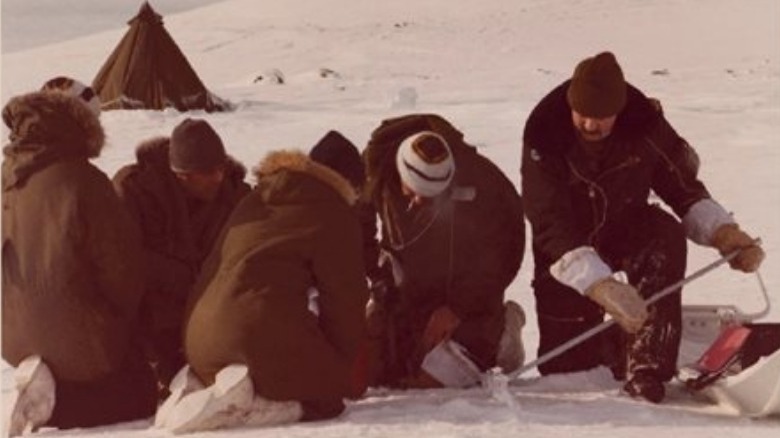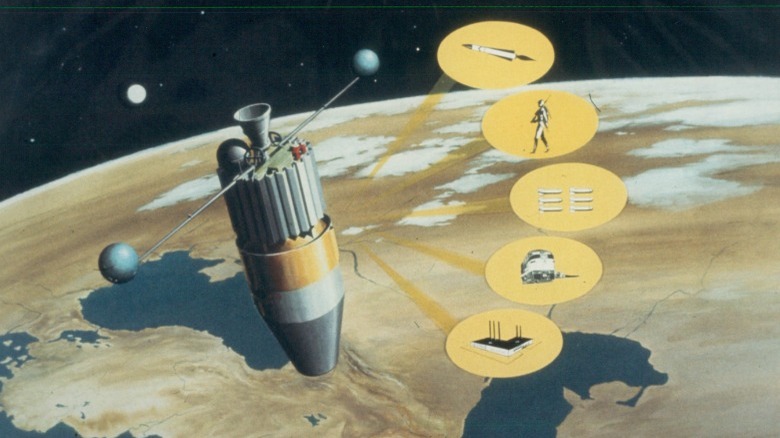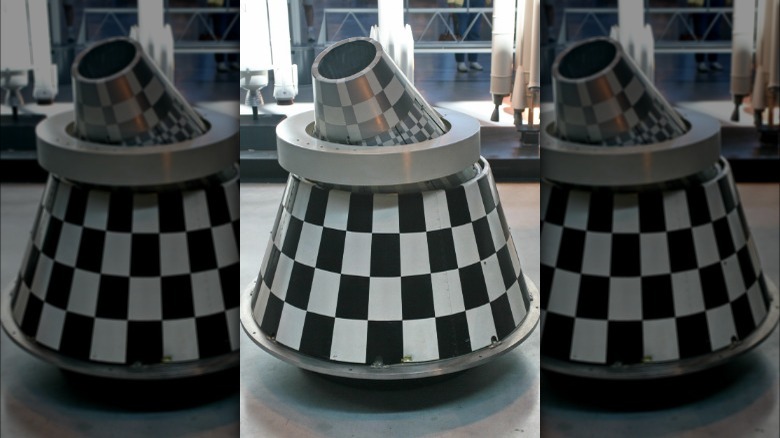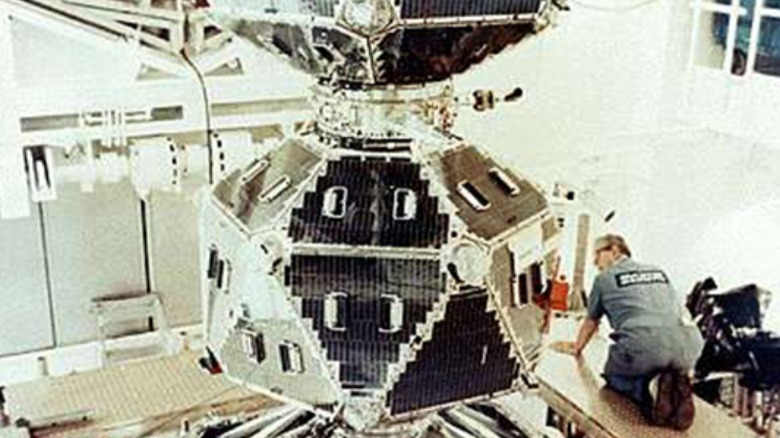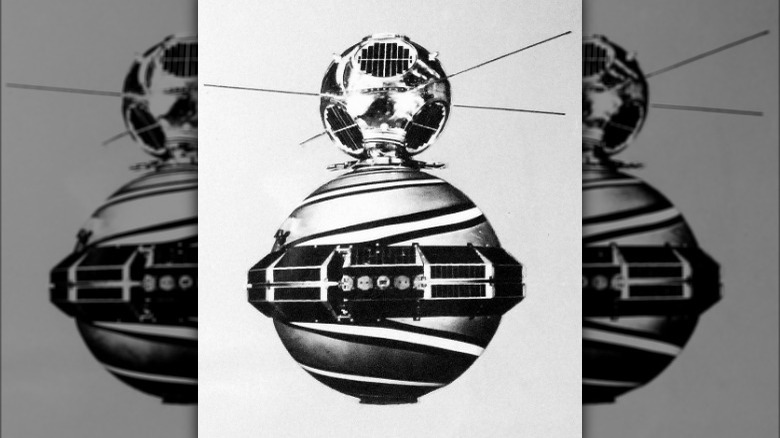10 Spy Satellites That Soared Through Space In The Cold War
International relationships are tricky. Many nations want to be the big superpower that all other countries look up to and/or fear. When two nations with drastically different political ideologies try to fill that niche, butting heads is inevitable and can lead to war — or an era of paranoia where everyone spies on everyone else under the assumption they are preparing for war.
The Cold War, which lasted from 1947 to 1991, was a period of high geopolitical tension, primarily between the U.S. and the Soviet Union. The Cold War didn't involve any actual all-out wars between these countries, but they were certainly gearing up for war, if only because each was confident the other nation would try to strike first. This era was epitomized by propaganda, proxy wars (supporting opposing sides in battles without actually getting involved), and most important of all, espionage. The U.S. and Soviet Union tried to outmaneuver each other with new spying techniques and technologies, many of which utilized the then-recent invention known as space satellites. After the Soviet Union beat America to the final frontier with the 1957 launch of Sputnik, an arms race began to out-spy the other country. Some of these reconnaissance satellites were so effective that they birthed space programs that are still around today, while others crashed and burned, both figuratively and literally.
Here are 10 spy satellites that orbited the globe during the Cold War.
CORONA
After the Soviet Union launched Sputnik, the U.S. had to play catchup. In 1958, the country sent its own satellite, Explorer 1, into orbit, but U.S. scientists required another year to finally capitalize on the new technology and spy on their Russian rivals.
The CORONA line of satellites was the U.S.' first fully functioning orbiting photographic reconnaissance program. The U.S. began constructing these satellites because, among other reasons, officials were sick and tired of the Soviets destroying U-2 spy planes and wanted something they couldn't shoot down. The first CORONA satellite, publicly known as Discoverer 1 (because much of espionage is ensuring nobody knows you're spying on them), was a proof of concept instead of an actual spy satellite. The U.S. wanted to guarantee their satellites could broadcast properly and achieve appropriate orbits before they started any reconnaissance.
The actual spy CORONA satellites, also known as KeyHole (or KH), started launching in 1960 and stayed in operation for 12 years. These satellites collectively took over 800,000 images, which required 2.1 million feet of film. Originally, imaging resolution started at 25 feet, but as the CORONA program went on, camera resolution improved to as much as 6 feet.
The CORONA program officially ended in 1972 when the satellites were phased out for more efficient and advanced spy satellites.
GAMBIT
The most important rule in the spy game is to always keep evolving. Just because espionage tech was top of the line once, doesn't mean it will stay that way. You have to think three moves ahead and develop the next line of spy satellites even when the current one is in use.
Several years after the launch of the first CORONA satellite, the U.S. started launching its successor, the GAMBIT. The first GAMBIT, GAMBIT 1 (also known as KeyHole-7) improved on the CORONAs with higher resolution photography, thanks in no small part to its then-revolutionary stereo cameras. While the GAMBIT 1 only stayed in service from 1963 to 1967, its successors saw much more action. The GAMBIT 3 (KeyHole-8) satellites flew from 1966 to 1984. This satellite also improved on the GAMBIT 1 design with even higher resolution, super-thin film, and a roll joint that made the satellite far more stable and film efficient.
While the GAMBIT satellites were far more advanced than the CORONAs, they shared one design flaw. In order to send the film back to the U.S. military, the orbiting cameras had to jettison the rolls with specialized "buckets," and to retrieve them, the U.S. had to send out equally-specialized film recovery vehicles. While most buckets were retrieved mid-air, they could float in the ocean if necessary. This method of film retrieval left the satellites and their cameras floating in space, cluttering high-altitude airspace after use.
HEXAGON
The CORONA and GAMBIT satellites were all about resolution. They were designed to zoom in as much as possible and determine if what looked like grain silos were actually missile silos (or vice versa). However, that strength came with a weakness: How do you know what something looks like if you don't even know what to look for? Zooming is useless unless you see something that needs a closer inspection, which is where the HEXAGON came in.
While the HEXAGON satellites were also known as KeyHole-9 satellites, they weren't upgrades of the GAMBITs. Instead, HEXAGONs were designed for wide-search photography. To fulfill this role, each HEXAGON satellite was equipped with two cameras called "optical bar cameras" that spun on axes to take overlapping, panoramic pictures. Because HEXAGONs weren't designed for resolution, GAMBIT satellites were sent in for follow-ups with their special zooming cameras.
The U.S. operated HEXAGON satellites from 1971 to 1986, making them the last U.S. reconnaissance satellites to return film to Earth during the Cold War. Moreover, to support its pirouetting panorama cameras, HEXAGONs were larger than other spy satellites. In fact, the HEXAGONs were arguably the largest reconnaissance satellites constructed. But, that size let them record 877 million square miles worth of intel during their tenure. For comparison, Earth has 197 million square miles of space, only 29% of which is dry land.
Zenit
After the Soviet Union won the race to launch a satellite into orbit during the middle of international tensions, their scientists quickly thought of ways to turn this new technology into a reconnaissance gold mine. However, while U.S. spy satellites had to jettison their film and leave their cameras floating in space, the Soviet equivalent was a little more economical.
The Zenit line of satellites — publicly called the Kosmos satellites to confuse prying eyes — was a series of imaging satellites that were launched starting in 1961. Like their American counterparts, Zenits were designed to photograph key locations, but unlike the CORONA satellites, Zenits didn't drop canisters full of exposed film. Instead, Zenits landed in one piece, cameras and all, which let them be reused for future missions. To achieve this feat, Zenits borrowed heavily from the Soviet Union's Vostok spacecraft design.
The first Zenit satellite, Zenit-2 (there was no Zenit-1) failed to launch properly and is presumed to have crashed somewhere in Siberia. However, the second Zenit attempt proved so successful that Russia continued to use Zenits even after the Soviet Union dissolved. While the Zenit satellites underwent several upgrades during the program's line, the final Zenit launched in 1994.
[Featured image by Maryanna Nesina via Wikimedia Commons | Cropped and scaled | CC BY 2.0]
Kosmos 954
As previously stated, whenever the Soviet Union launched a Zenit satellite, they claimed it was a Kosmos satellite because the spy business is a lot like a game of poker: showing your hand is a bad idea. Ironically, one of the Soviet Union's legitimate Kosmos satellites was also used for espionage. It didn't end well.
In September of 1977, the Soviet Union launched the Kosmos 954. This satellite was designed as a long-term method of tracking U.S. ships. The Kosmos 954 utilized powerful radar and radio systems and was capable of tracking surface boats and submarines, and to keep the satellite running for years on end, Soviet scientists equipped the Kosmos 954 with a nuclear reactor. However, the probe didn't even last a few months, and on January 24, 1978, it came crashing down to Earth.
The Kosmos 954 broke up while reentering the atmosphere, which wouldn't have been a major problem if not for the aforementioned nuclear payload. Chunks of nuclear satellite, including enriched uranium 235 (which has a half-life of 713 million years), rained down across the Canadian wilderness. To retrieve the deadly debris, the Canadian government initiated Operation Morning Light, but only an infinitesimal amount of the Kosmos 954's radioactive fuel was recovered. However, this disaster was actually a best-case scenario. According to anonymous space scientists, had Kosmos 954 stayed in orbit for just one more pass, it probably would have crashed into New York City.
SAMOS
The CORONA satellites were the U.S.'s first line of successful spy satellites, but the devil is in the details; these were the first successful satellites. The U.S. launched other spy satellites as well, and we don't just mean the proof-of-concept Discoverer ones.
The SAMOS 1 (sometimes called the SAMOS-E1) was designed as a rival to the CORONA satellites. Like its counterpart, the SAMOS 1 photographed key targets, but instead of dropping buckets of exposed film, the SAMOS 1 was supposed to electronically scan the pictures and radio them back to HQ — we say "supposed" because the first SAMOS satellite lost guidance and control systems and was unable to send any data.
For one reason or another, subsequent SAMOS launches ended with similarly disastrous results. Some ran out of electricity or fuel, while others lost heat shields. At least one SAMOS satellite even exploded. To pour salt in the wound, each SAMOS failed in its primary mission of providing usable intel. The SAMOS project ran from 1960 to 1962 before the U.S. government terminated it. Despite being less advanced, the CORONA satellites won out in the end.
[Featured image by National Reconnaissance Office via Wikimedia Commons | Cropped and scaled | CC BY 2.0]
MIDAS
Not all spy satellites were designed for reconnaissance. Some were created to serve as early warning systems, just in case a foreign power decided to pull the trigger and launch their nukes.
The Missile Defense Alert System (MIDAS for short) was exactly what it sounded like: a series of satellites developed for the sole purpose of detecting and tracking Soviet Intercontinental Ballistic Missiles (ICBMs). Each MIDAS satellite utilized infrared sensors, which were simple in execution but fairly effective.
While development of early warning satellites began in 1948, the MIDAS satellites weren't finalized and launched until 1960. The first MIDAS lost communication fairly quickly, but the program finally saw fruition in 1963 with the MIDAS 7. To demonstrate the satellite's capabilities, the U.S. launched Minuteman and Polaris missiles, and the MIDAS satellite successfully detected these missiles as intended. A total of 12 MIDAS satellites were developed and launched before the program was phased out. While the MIDAS program didn't live up to expectations, it still demonstrated that an infrared-based early warning system was feasible. But, the U.S. had to wait until 1970 to see that dream become a reality.
[Featured image by Cliff via Wikimedia Commons | Cropped and scaled | CC BY 2.0]
Defense Support Program
While the MIDAS satellites weren't a rousing success, they weren't a devastating failure, either; they demonstrated that U.S. ambitions outstripped the country's technological capabilities, but not by much. The U.S. had to develop more advanced satellite tech, and as history has shown multiple times, nothing spurs on technological advancements quite like a war, cold or otherwise.
In November of 1970, the U.S. government launched the first successor to the MIDAS satellites, the Defense Support Program (DSP) satellite. Like many reconnaissance satellites before it, the first DSP ran into trouble during launch, but the second one successfully entered orbit over the equator and led to subsequent DSP launches.
Like the MIDAS satellites, DSPs relied on infrared sensors to detect missiles, specifically the heat of their boosters. However, DSP satellites were more effective than their MIDAS precursors, partially because they were harder to jam. In fact, DSPs were so effective that researchers accidentally discovered that the satellites could detect Soviet Backfire bombers. This revelation eventually led to two new reconnaissance programs: SLOW WALKER and FAST WALKER.
Not only did the U.S. rely on the DSP program for the rest of the Cold War, but the country kept sending these satellites into space well after the geopolitical era's end. The final DSP satellite was launched in November 2007. Even though the DSP satellites were intended to detect ICBMs, they were just as effective at tracking short-range missiles, as the satellites were crucial during Operation Desert Storm when Iraqis launched Scud missiles.
Vela
During the Cold War, many people were scared of the threat of nuclear annihilation. After all, the Hiroshima and Nagasaki bombings were still fresh in countless minds. To prevent a repeat of such events, numerous countries signed a treaty to ban nuclear tests. However, a treaty is all but worthless unless you can enforce it — or at least know when somebody breaks it.
The Vela program was founded for the express purpose of ensuring countries adhered to the 1963 Partial Test Ban Treaty. To achieve this, the U.S. launched multiple satellites equipped with X-ray, neutron, and gamma-ray detectors. To ensure maximum coverage, Vela satellites were launched in pairs and orbited around the Earth at opposite points. The first successful Vela satellites were launched in May of 1969.
While the Vela satellites were largely considered a success, they were prone to false positives. In 1972, a massive solar storm confused the satellites, and in 1978, they recorded a mysterious phenomenon that created a large, audible boom over Bell Island, Canada. Fittingly called the Bell Island Boom, many believe this event was caused by a rare and powerful lightning bolt known as a superbolt, not a nuclear explosion. However, in 1979, a Vela satellite also recorded a double flash of light near the Prince Edward Islands, which lie south of South Africa. Several decades after this event, which became known as the Vela Incident, declassified documents confirmed that a surprise joint atomic test carried out by Israel and South Africa caused the explosion.
SOLRAD/GRAB/GREB 1
Good spies don't attract attention to themselves. For instance, if you are supposed to gather information while posing as a tailor, you better learn how to alter dresses. Heck, alter dresses better than anyone else around; hide right under your target's noses by standing out. The same rule also applies to satellites.
Many satellites mentioned in this article had alternate public identities that hid their true purposes, but the SOLRAD 1 not only served its purported purpose as a scientific spacecraft but also pulled double duty as a spy satellite. The probe was equipped to measure solar radiation, and when it returned to Earth, the satellite contained relevant scientific data. Yet the SOLRAD 1 also lived the double life of the GREB 1 (or sometimes GRAB), a spy satellite that received Soviet radar signals and recorded them to map out their installations.
The SOLRAD 1 launched in June 1960 and collected far more data than expected. Mostly, anyway. The satellite was supposed to detect atomic tests, but it didn't find any — the SOLRAD 1 mission predated the Partial Nuclear Test Ban Treaty that the Vela satellites were designed to help enforce. On the bright side, the SOLRAD 1's lack of nuclear explosion data could imply that, from 1960 to 1962, no Soviet nations tested atomic weapons above ground.
